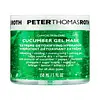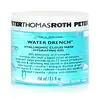What's inside
What's inside
 Key Ingredients
Key Ingredients

No key ingredients
 Benefits
Benefits

 Concerns
Concerns

 Ingredients Side-by-side
Ingredients Side-by-side

Water
Skin ConditioningButylene Glycol
HumectantCucumis Sativus Fruit Extract
EmollientAnanas Sativus Fruit Extract
Skin ConditioningVaccinium Myrtillus Fruit/Leaf Extract
AstringentCarica Papaya Fruit Extract
Skin ConditioningAcer Saccharum Extract
Skin ConditioningSaccharum Officinarum Extract
MoisturisingAloe Barbadensis Leaf Juice
Skin ConditioningChamomilla Recutita Flower Extract
MaskingChamomilla Recutita Flower Oil
MaskingCitrus Limon Fruit Extract
MaskingCitrus Aurantium Dulcis Fruit Extract
MaskingMangifera Indica Fruit Extract
Skin ConditioningSodium PCA
HumectantAllantoin
Skin ConditioningGlycerin
HumectantPropylene Glycol
HumectantDisodium EDTA
Sodium Hydroxide
BufferingCitric Acid
BufferingCarbomer
Emulsion StabilisingTriethanolamine
BufferingPolysorbate 20
EmulsifyingPotassium Sorbate
PreservativeSodium Benzoate
MaskingPhenoxyethanol
PreservativeCI 19140
Cosmetic ColorantCI 42090
Cosmetic ColorantWater, Butylene Glycol, Cucumis Sativus Fruit Extract, Ananas Sativus Fruit Extract, Vaccinium Myrtillus Fruit/Leaf Extract, Carica Papaya Fruit Extract, Acer Saccharum Extract, Saccharum Officinarum Extract, Aloe Barbadensis Leaf Juice, Chamomilla Recutita Flower Extract, Chamomilla Recutita Flower Oil, Citrus Limon Fruit Extract, Citrus Aurantium Dulcis Fruit Extract, Mangifera Indica Fruit Extract, Sodium PCA, Allantoin, Glycerin, Propylene Glycol, Disodium EDTA, Sodium Hydroxide, Citric Acid, Carbomer, Triethanolamine, Polysorbate 20, Potassium Sorbate, Sodium Benzoate, Phenoxyethanol, CI 19140, CI 42090
Hyaluronic Acid 20%
HumectantPentane
SolventTocopherol
AntioxidantCaffeine
Skin ConditioningWater
Skin ConditioningGlycerin
HumectantPolysorbate 20
EmulsifyingCarbomer
Emulsion StabilisingPropylene Glycol
HumectantSodium Hyaluronate
HumectantSaccharide Isomerate
HumectantSodium PCA
HumectantSodium Hydroxide
BufferingAloe Barbadensis Leaf Juice
Skin ConditioningCitric Acid
BufferingTocopheryl Acetate
AntioxidantMenthol
MaskingEucalyptus Globulus Leaf Extract
PerfumingSodium Citrate
BufferingMenthoxypropanediol
MaskingSodium Phytate
Sodium Benzoate
MaskingPotassium Sorbate
PreservativeEthylhexylglycerin
Skin ConditioningCI 42090
Cosmetic ColorantPhenoxyethanol
PreservativeHyaluronic Acid 20%, Pentane, Tocopherol, Caffeine, Water, Glycerin, Polysorbate 20, Carbomer, Propylene Glycol, Sodium Hyaluronate, Saccharide Isomerate, Sodium PCA, Sodium Hydroxide, Aloe Barbadensis Leaf Juice, Citric Acid, Tocopheryl Acetate, Menthol, Eucalyptus Globulus Leaf Extract, Sodium Citrate, Menthoxypropanediol, Sodium Phytate, Sodium Benzoate, Potassium Sorbate, Ethylhexylglycerin, CI 42090, Phenoxyethanol
 Reviews
Reviews

Ingredients Explained
These ingredients are found in both products.
Ingredients higher up in an ingredient list are typically present in a larger amount.
Aloe Barbadensis Leaf Juice comes from leaves of the aloe plant. Aloe Barbadensis Leaf Juice is best known for helping to soothe sunburns. It is also anti-inflammatory, moisturizing, antiseptic, and can help heal wounds.
Aloe is packed with good stuff including Vitamins A, C, and E. These vitamins are antioxidants, which help fight free-radicals and the damage they may cause. Free-radicals are molecules that may damage your skin cells, such as pollution.
Aloe Barbadensis Leaf Juice also contains sugars. These sugars come in the form of monosaccharides and polysaccharides, folic acid, and choline. These sugars are able to help bind moisture to skin.
It also contains minerals such as calcium, 12 anthraquinones, fatty acids, amino acids, and Vitamin B12.
Learn more about Aloe Barbadensis Leaf JuiceCarbomer is a polymer of acrylic acid. Its main role is to create a gel consistency.
A high amount of carbomer can cause pilling or balling up of products. Don't worry, most products contain 1% or less of carbomer.
Ci 42090 is a synthetic dye created from petroleum. It is used to give a bright blue color to cosmetics, medicine, and food.
Citric Acid is an alpha hydroxy acid (AHA) naturally found in citrus fruits like oranges, lemons, and limes.
Like other AHAs, citric acid can exfoliate skin by breaking down the bonds that hold dead skin cells together. This helps reveal smoother and brighter skin underneath.
However, this exfoliating effect only happens at high concentrations (20%) which can be hard to find in cosmetic products.
Due to this, citric acid is usually included in small amounts as a pH adjuster. This helps keep products slightly more acidic and compatible with skin's natural pH.
In skincare formulas, citric acid can:
While it can provide some skin benefits, research shows lactic acid and glycolic acid are generally more effective and less irritating exfoliants.
Most citric acid used in skincare today is made by fermenting sugars (usually from molasses). This synthetic version is identical to the natural citrus form but easier to stabilize and use in formulations.
Read more about some other popular AHA's here:
Learn more about Citric AcidGlycerin is already naturally found in your skin. It helps moisturize and protect your skin.
A study from 2016 found glycerin to be more effective as a humectant than AHAs and hyaluronic acid.
As a humectant, it helps the skin stay hydrated by pulling moisture to your skin. The low molecular weight of glycerin allows it to pull moisture into the deeper layers of your skin.
Hydrated skin improves your skin barrier; Your skin barrier helps protect against irritants and bacteria.
Glycerin has also been found to have antimicrobial and antiviral properties. Due to these properties, glycerin is often used in wound and burn treatments.
In cosmetics, glycerin is usually derived from plants such as soybean or palm. However, it can also be sourced from animals, such as tallow or animal fat.
This ingredient is organic, colorless, odorless, and non-toxic.
Glycerin is the name for this ingredient in American English. British English uses Glycerol/Glycerine.
Learn more about GlycerinPhenoxyethanol is a preservative that has germicide, antimicrobial, and aromatic properties. Studies show that phenoxyethanol can prevent microbial growth. By itself, it has a scent that is similar to that of a rose.
It's often used in formulations along with Caprylyl Glycol to preserve the shelf life of products.
Polysorbate 20 is made by combining ethoxylation of sorbitan, ethylene oxide, and lauric acid. It is a mild cleansing agent, surfactant, and emulsifier.
As a surfactant, it helps collect dirt and oils for washing. Emulsifiers prevent oils and water from separating.
Polysorbate 20 also adds scent to a product. Since it is made using sorbitol, it has a sweet scent. Sorbitol can also be found in fruits such as apples and peaches.
The lauric acid used to create Polysorbate 20 is often derived from coconuts.
Polysorbate 20 may not be fungal acne safe.
Learn more about Polysorbate 20Potassium Sorbate is a preservative used to prevent yeast and mold in products. It is commonly found in both cosmetic and food products.
This ingredient comes from potassium salt derived from sorbic acid. Sorbic acid is a natural antibiotic and effective against fungus.
Both potassium sorbate and sorbic acid can be found in baked goods, cheeses, dried meats, dried fruit, ice cream, pickles, wine, yogurt, and more.
You'll often find this ingredient used with other preservatives.
Learn more about Potassium SorbatePropylene Glycol is an odorless, colorless liquid. As a humectant, it helps skin retain moisture. It also aids in delivering active ingredients.
Another role of this ingredient is preventing a product from melting or freezing. Propylene glycol also adds antimicrobrial properties to a product, elongating product lifespan.
This ingredient is considered an organic alcohol and commonly added into both cosmetics and foods.
Those with sensitive skin or conditions may develop a rash when using this ingredient.
Learn more about Propylene GlycolSodium Benzoate is a preservative. It's used in both cosmetic and food products to inhibit the growth of mold and bacteria. It is typically produced synthetically.
Both the US FDA and EU Health Committee have approved the use of sodium benzoate. In the US, levels of 0.1% (of the total product) are allowed.
Sodium benzoate works as a preservative by inhibiting the growth of bacteria inside of cells. It prevents the cell from fermenting a type of sugar using an enzyme called phosphofructokinase.
It is the salt of benzoic acid. Foods containing sodium benzoate include soda, salad dressings, condiments, fruit juices, wines, and snack foods.
Studies for using ascorbic acid and sodium benzoate in cosmetics are lacking, especially in skincare routines with multiple steps.
We always recommend speaking with a professional, such as a dermatologist, if you have any concerns.
Learn more about Sodium BenzoateSodium Hydroxide is also known as lye or caustic soda. It is used to adjust the pH of products; many ingredients require a specific pH to be effective.
In small amounts, sodium hydroxide is considered safe to use. However, large amounts may cause chemical burns due to its high alkaline.
Your skin has a natural pH and acid mantle. This acid mantle helps prevent harmful bacteria from breaking through. The acid mantle also helps keep your skin hydrated.
"Alkaline" refers to a high pH level. A low pH level would be considered acidic.
Learn more about Sodium HydroxideSodium PCA is the sodium salt of pyroglutamic acid. It is naturally occurring in our skin's natural moisturizing factors where it works to maintain hydration.
The PCA stands for pyrrolidone carboxylic acid, a natural amino acid derivative.
This ingredient has skin conditioning, anti-inflammatory, and humectant properties. Humectants help hydrate your skin by drawing moisture from the air. This helps keep your skin moisturized.
Learn more about Sodium PCAWater. It's the most common cosmetic ingredient of all. You'll usually see it at the top of ingredient lists, meaning that it makes up the largest part of the product.
So why is it so popular? Water most often acts as a solvent - this means that it helps dissolve other ingredients into the formulation.
You'll also recognize water as that liquid we all need to stay alive. If you see this, drink a glass of water. Stay hydrated!
Learn more about Water